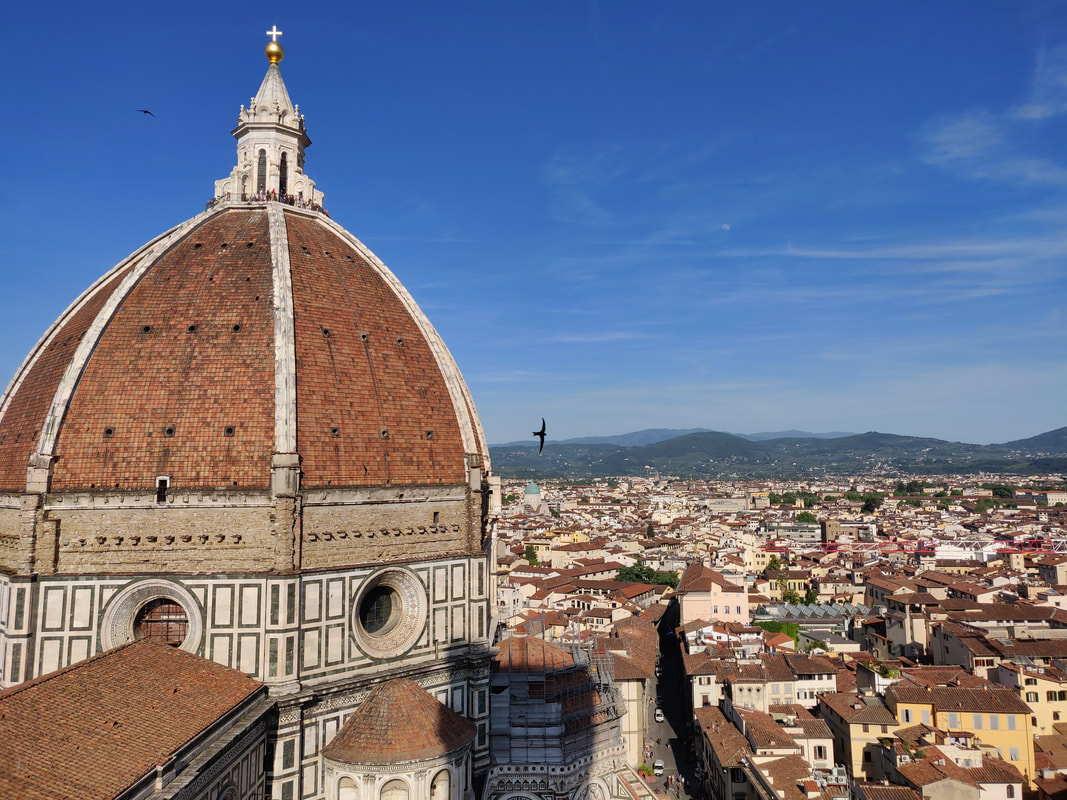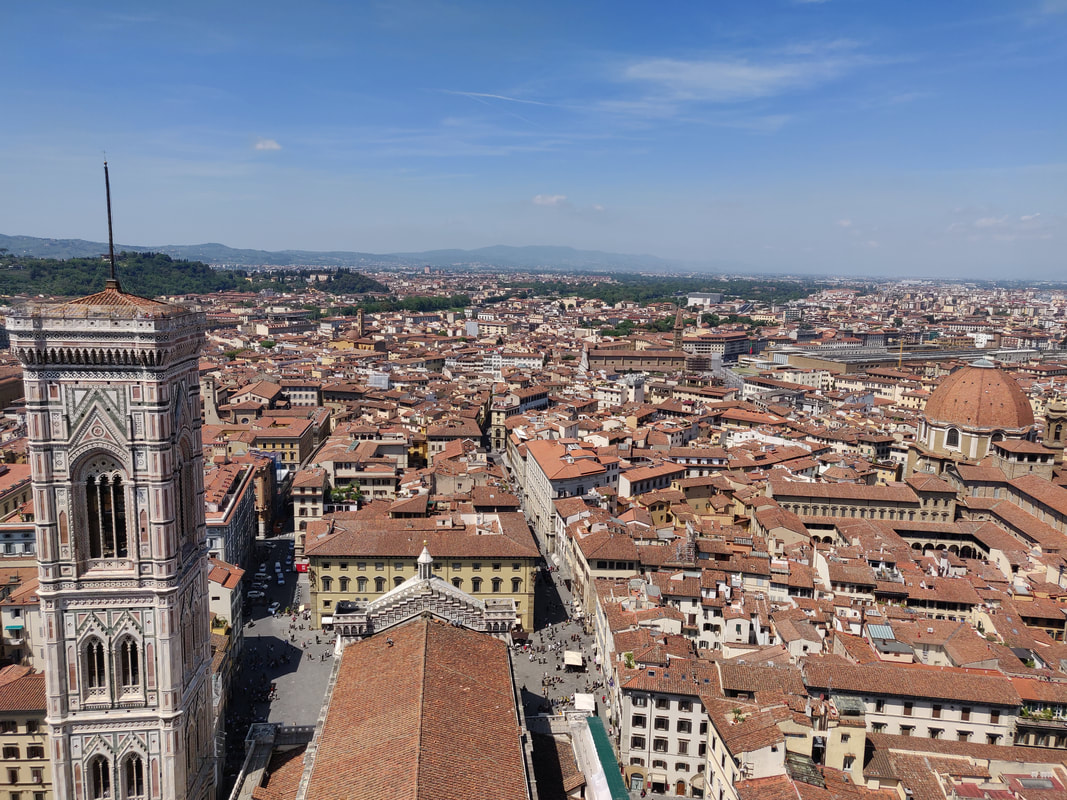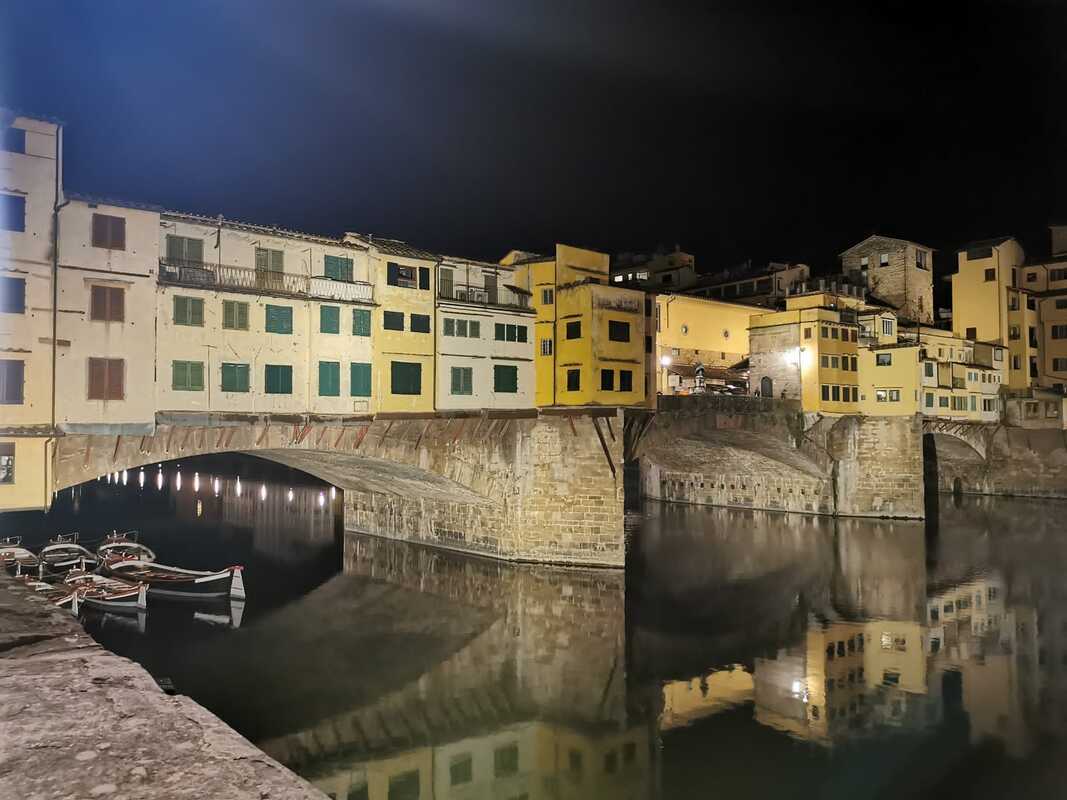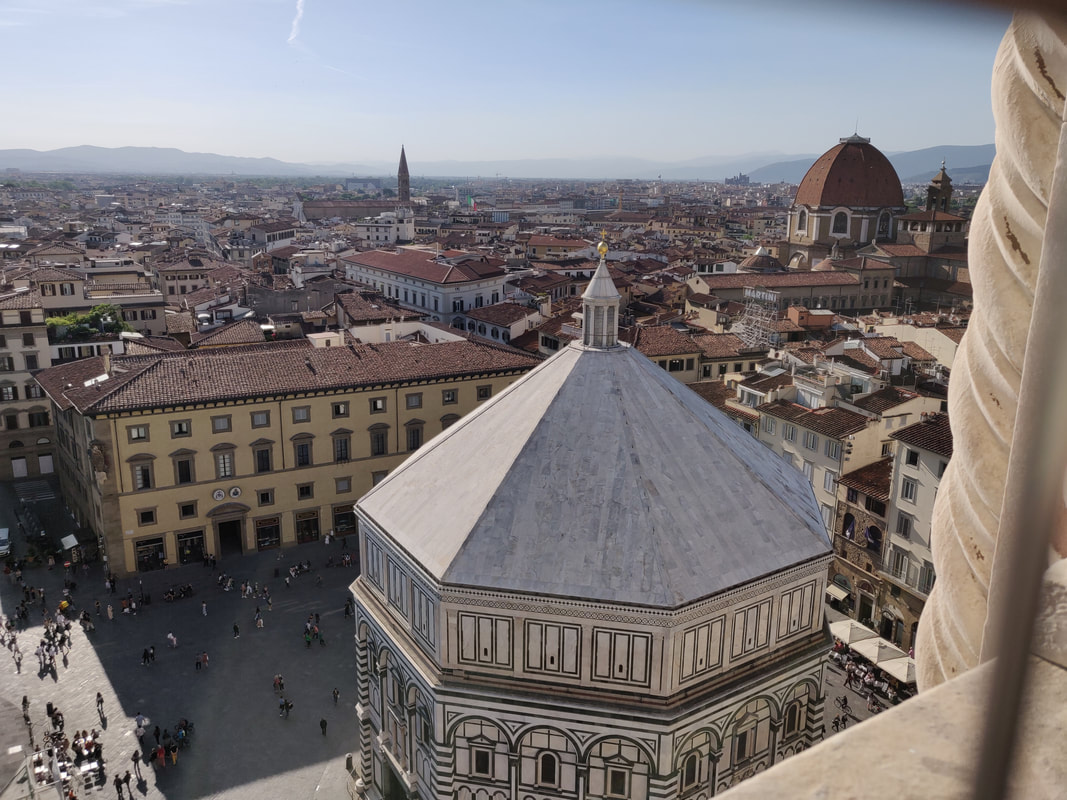SummaryAirport Rating ***** Reception of locals ***** Cost: ££££
Home of the RenaissanceThere aren't too many cities on this planet that have had a bigger impact on human history than Florence. That may seem a strong statement, but a revolution of liberal values in 14th century Florence kickstarted the enlightenment on which much of the modern world rests. For two centuries, the economy of Florence drove development throughout much of Europe. Excess capital from trade and banking was spent on large scale art, literature and architectural projects that delivered new forms of communication, culture and engineering. While the history of Florence predates the Roman period as an Etruscan city, it became a settlement of greater standing during the period of Roman rule. After centuries of successive invasions, it emerged in the 12th century as a significant regional power which was based on a relatively plutocratic society. While in most countries power rested in the hands of a small aristocracy (or a single autocratic ruler), in Florence the merchant class wielded significant power. This enabled development that would aid a broader section of society, so rather than wars of ego led by kings and queens, the success of Florence rested on open exchange of people, ideas and capital - and so war was something to be avoided. Florence, at the time, was also home to some of the largest banking families in Europe - the most famous of which were the Medicis. The House of Medici was instrumental in both the rise and fall of Florentine power, but their control over trade and finances through their banking network set them up as informal and, eventually, formal rulers of Florence and the surrounding areas. Their patronage did much to kick start the Renaissance as they paid leading philosophers, artists and architects to move to Florence from all over Italy, commissioning large projects for them to work on. Eventually, a plutocratic society became increasingly centralised, and more militaristic neighbours began dominating the city state. As the centre of banking spread north to Amsterdam and then to London and as key trading posts in the Middle East were circumvented by north Atlantic countries, the power of Florence also waned - but not before leaving its mark on modern Italy and further afield. It was the second capital of a unified Italy and todays Italian language owes much to the Florentine dialect of the 14th century. It remains one of the richest cities in the Italian peninsula, and its incredible history draws tourists from all the over world making it one of the most visited and photographed cities on the planet. Art and ArchitectureMuch like Rome (which you can read about here), Florence is a living museum with history all around. You can barely turn a corner without seeing a building, square or art work with a storied history. That being said, to see some of the best art, you have to pay to get into one of the many museums and art galleries in the city. While there are more museums than I could possible visit in a week, five of the top 15 most visited museums reside in the city and two really stand out - the Uffizi Gallery, and the Accademia Gallery. Both museums require pre-booking online given how busy they get (and they get incredibly busy), and tickets aren't cheap (€24 for the Uffizi and €16 for Accademia). The Uffizi gallery is one of the oldest "modern" museums, opening to the general public in 1865 and is unmatched in Italy in relation to its art collection - housing the largest amount of Renaissance work in the world. The museum hosts a collection acquired by the Medici family and was bequeathed to the city when the line of descent ended. It's important to buy tickets online beforehand as queues can get pretty insane. Inside, the museum is decorated as extravagantly as you'd expect, and boasts some impressive views of Florence Cathedral. Unfortunately, while there was a lot of artwork, most of it was lost on me. I have mentioned over the years that I don't quite understand art as much as I'd like to, and after the first few rooms, it all felt the same to me. But if you're into art, particularly from the Renaissance, I'd imagine you'd have an amazing time here. The Accademia Gallery is much smaller and is built almost exclusively around one sculpture, Michelangelo's David. The 5+ metre sculpture of the biblical King David dates back to the first years of the 16th century, and given how well it is known in the mainstream, I was pretty excited to see it in reality. It's one of those few things that are even more impressive in real life than in photos or videos. The sculpture was much larger than I expected, dominating the large room in which it was situated. The perimeter was surrounded by tourists, jostling for the best selfie, but given the size of the statue it doesn't matter where you are, everywhere provides a good vantage point. There isn't a whole lot else to note, but for David alone, I'd recommend a visit. The architecture of Florence is nothing short of magnificent, dominated by Florence Cathedral - the largest brick construction of its kind in the world. When built it was the largest domed building in the world and the first large scale dome construction in Europe since Roman times. Construction began in the 13th century, but the final external facade decorations weren't completed until the 19th century. The intricate facade featuring red, green and white marble gives a visual unlike anything else I've seen in my life, and sitting on the nearby Plaza del Duomo staring at the UNESCO World Heritage Site which includes the cathedral is an experience that'll stay with me for a long time (I also met a white Italian kesadhari Sikh from Brescia who was showing his students around and explained how he got into Sikhi from learning through recent immigrants to the Brescia region - shoutout to Fabrizio Singh). The cathedral and in particular its large dome can be seen from many different parts of the city, and is the focal landmark of Florence. It's free to enter the cathedral - but the cathedral itself isn't particularly spectacular - especially when compared to others in Italy. The real beauty is in climbing the dome, an experience I found similar to climbing the dome at St Peter's Basilica in the Vatican City (which you can read about here). The climb is a decent length, and as the passageways narrow it can get slightly dizzying, but for most it should be comfortable. You also have a level inside where you walk along the interior of the dome, right next to the incredible paintings on the ceiling of the dome, while being able to look down across the cathedral below. It's pretty incredible how architects and engineers like Filippo Brunelleschi almost a thousand years ago designed and built such a beautiful, large and self supported dome without the aid of computer modelling that you have today. The best ticket to buy costs €30 but also gives you access to several other nearby landmarks. One of these is the adjacent Baptistery of St John which predates the cathedral and is one of the oldest buildings in the city. While the three artistically different doors are impressive, the real beauty is in the octagonal ceiling, a shimmering gold of artwork crowning what is a pretty dark room. The best views of the cityBack to the cathedral, climbing the dome gives you a fantastic view of the city. You can see the terracotta styled houses extending into the distance, broken up by the shimmering white of different churches dotted around the city. Security is on hand to make sure the exterior doesn't get too busy, and you get a decent amount of time to walk the perimeter and make the most of the views. Perhaps the most impressive building is the nearby Giotto's Campanile, a large Gothic bell tower decorated in the same style of the baptistery and cathedral. Giotto's Campanile is the third of the landmarks you get access to as part of your ticket, and its 414 steps lead to a view even better than the dome of the cathedral - after all, if you are on top of the dome, you can't see the dome, the most stunning building in the city. The view from the bell tower fixes that by giving you the best view of the dome as it's situated right next to cathedral. Giotto's Campanile is almost 85 metres tall and began construction in the 14th century and forms part of the broader UNESCO World Heritage site that includes the cathedral and the baptistery. I climbed both the dome and the bell tower on the same day, and the second climb felt more tiring. There are a couple of external breaks on the way, but the views from the top are incredible. You're so close to the dome that you can actually see people who have climbed the dome from your position on the roof of the bell tower. While the views from the cathedral and bell tower are stunning, the best way to get a panoramic vista of the city is to go slightly outside of the centre, on Piazza Michelangelo. There, a lookout point provides an incredible view across the city and you can see this both during the day and evening. While it can get busy, the large footprint of the lookout means there are plenty of places to relax and enjoy the numerous landmarks of the city. It's also quite nice to be slightly removed from the busy, narrow, mazy passageways in the city centre. There are numerous ways to get to Piazza Michelangelo from the city centre, you can get a bus, a cycle, or you can walk (which is what I did), although a roundtrip from the city centre can take a couple of hours on foot. There are other superb places dotted throughout the city that provide rooftop views of the architecture of the city including many bars and restaurants. The View on Art rooftop is one place that offers an incredible view of the cathedral complex and is lively during the evenings. A bridge to the pastThe Ponte Vecchio (or 'old bridge') was a landmark I was particularly interested to see. Allegedly dating back to Roman times, the bridge is part of the historical record since at least 996ad, although it was swept away by the River Arno and rebuilt several times since. Dotted along the bridge - as was the case with many bridges in those times - were vendors selling all manner of things to travellers crossing from one side of the river to the other. What separates this from many other bridges is that those vendors are still operating on the bridge today, distinguishing it from others in the cities. The beauty of the bridge spared it from destruction during the German occupation and retreat from the city during the Second World War, with the bridge being the only one spared as others were blown up to slow down the Allied advance. Today the bridge is busy attraction throughout the day and late into the evening when people gather around to watch performers and entertainers. The bridge is lined with goldsmiths and jewellers due to an edict in the 16th century that outlawed many other types of businesses like butchers in order to clean up the bridge and the surrounding waterways. A short walk along the river brings you to the Amerigo Vespucci bridge - a Florentine native after whom the continents of America are named. The bridge provides a more modern crossing but also has a small area under the bridge next to River Arno where people sit, relax and have food and drink. You can climb down from the far side of the river and sit next to the flowing waters as they shift around a lock that provides a dry area. It's a pretty cool place to hang out. From Tuscan Traders to a modern metropolisThe old traders of the old bridge are long gone, and today you're just as likely to find Rolex on the Ponte Vecchio as you are traditional Italian manufacturers. It's a story of the city as a whole. As you cross the bridge into the city centre core, the buildings are slightly more modern given the destruction caused in this area during the Second World War. The streets are lined with high-end fashion shops with prices that are out of reach of most people. Multinational corporations sit next to exclusive boutiques which makes Florence an important city of fashion in Italy. Food is an important part of Tuscan cuisine and its largely meat based (so for my vegetarian readers, things can get slightly tricky). Florence is famed for its steak and sandwiches and there are sandwich places dotted around the city. Food is pretty expensive in the most tourist heavy places in the city, but become cheaper the further you venture out. I particularly enjoyed Mercato Centrale, a food hall with many different types of food all under one roof. The prices are slightly on the expensive side, but there is a nice energy about the place and it's open late into the evening. There are also very nice places to relax, my favourite was Le Murate, an outside area where people can get together and unwind while sitting on old window panels and even playground swings. Shops of all kinds cater to tourists from around the world, which during the busy season outnumber the city's local residents. Some measures have been put in place to ensure that the city doesn't suffer from poor quality over-tourism that has been seen in Venice and Barcelona. Of particular concern are day trippers that don't spend money in the city, and the local council are trying to take steps to stop this kind of tourism. At the same time, the local authority have mandated that restaurants use locally sourced ingredients for their food and they recently rejected an application from McDonalds to build a restaurant in the historical core (although there is a large McDonalds near the main train station). I think these are positive steps. Globalisation and tourism have undoubtedly bought economic benefits to the city, but unfettered globalisation and mass tourism has the potential to create problems. During the week that I visited I heard significantly more American accents that Italian accents and the majority of people you bump into are either from other parts of the country or further afield. Would I recommend Florence?Absolutely, especially if you love art. Florence has the greatest concentration of art per capita than anywhere else in the world, but there is more to the city. If you appreciate good architecture, food and history, I would definitely recommend a visit. But you need to understand you won't be visiting a quiet Italian city. This is a city that has more tourists than locals during the busy season and the majority of these tourists are from the United States. If you don't like certain parts of Spain because they remind you of mini-England, you might not like Florence either. Americans aren't the most subtle of tourists, although almost all are well meaning and good hearted. However, you'll regularly bump into visitors that seem to living through a 'main character syndrome' - oblivious to their surroundings as they jostle for a perfect picture. Think Emily in Paris, but more like Britney in Florence. That being said, they seem happy, and at the end of the day you can't begrudge another person their happiness, no matter how strange it might seem. And in their defence, the behaviour of these American tourists is significantly better than Brits and Germans in Spain (and in the past, I've been one of those Brits in Spain). As a Sikh I thought the whole city was chill and had no problems at all throughout my visit. There aren't too many Sikhs in Florence, and no local Gurdwaras but there are people from all over the world here, and you're just another face in the crowd. The airport presented no problems, and getting from the airport to the city is very easy using public transport. Tram lines connect the airport to the city, criss crossing through key areas and a €1.50 ticket provides you with 90 minutes worth of travel on trams and buses, although it's a very walkable city. You also have the usual cycle and e-scooter hires that are popular in most cities. The Firenze Santa Maria Novella train station connects Florence with cities throughout the country and is a key hub in the national transport network, so day trips outside the city are pretty convenient. It's a thumbs up for Florence from me - but expect crowds! Comments are closed.
|
AuthorBritish Sikh, born in the Midlands, based in London, travelling the world seeing new cultures. Categories
All
|








 RSS Feed
RSS Feed